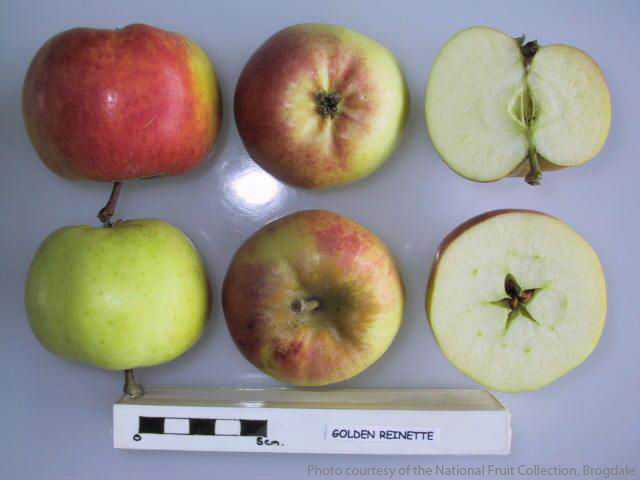Pomiferous
Welcome to the world's most extensive apples (pommes) database.
Information on over 7,000 apples is available here, all carefully researched and provided in a way that is easy to navigate.
Golden Reinette

type: Culinary, Cider, Dessert, Jelly, Pie
synonyms: This can be confusing. As is the case with many continental heritage apples, the Golden Reinette is known by 50 or more synonyms. Among these are: Aurore (not to be confused with Aurora ), Court-pendû dorée, Dundee, Elizabeth, English Pippin, Golden Renet, Golden Rennet, Kirke's Golden Reinette, Megginch Favourite, Pomme Madame, Princesse Noble, Reinette d’Aix, Reinette Gielen, Wygers, Wyker Pippin (not to be confused with Wyken Pippin ), Wykes Pippin, Yellow German Reinette. In addition, there are several other European varieties known by the name Golden Reinette, both formally or as synonyms. The Golden Reinette is often described as a Herfordshire (Britain) variety. In Pomologia Britiannica Vol. II (1856), John Lindley maintained that it is the Wyker Pippin of Dutch origin.
summary: Originated in Europe during the 1600s and spread by monks on their travels, later by explorers and settlers in the new world. It was likely the pollen parent of the Golden Delicious which emerged in the central United States during the late 1800s.
identification: Medium size, round and flattened, some ribbing may be present but it is often indistinct. The skin base colour is a rich yellow which is blushed red on the sun exposed face with streaks of bright red. Russetted lenticels are abundant on both faces. The stem is short and set in a deep, round cavity which is often russetted.
characteristics: The flesh is cream-coloured, crisp, sweet and juicy. Somewhat brisk with a fruity flavour and aroma.
uses: Widely used for making cider. By itself, it makes a sweet, slightly tangy and fruity, soft cider. For hard cider, use it for the sweet element for blending with sharp and bitter apples. Also used for baking and it keeps its shape when cooked.
origins: Though widely considered a considered a British varariety, the Golden Reinette originated in continental Europe during the 1600s. At one time considered a Hertfordshire (British) variety, the Golden Reinette was actually developed in Continental Europe and brought to the British Isles where it was widely distributed. It was further distributed to North America, as well as other parts of the New World, possibly through the 1700s. William Ellis, in a 1744 issue of his " Modern Husbandman," said, " The Golden Rennet., when of the largest sort, may be truly said to be the farmer's greatest favorite apple, because when all others miss bearing, this generally stands his friend, and bears him large quantities on one tree."
Edward A Bunyard, A Handbook of Hardy Fruits Commonly Grown in Great Britain, 1920 states "An old variety, which has been known in England for several hundred years. It is widely grown on the continent, and has over fifty synonyms. A nice fruit, but hardly of first-class quality now. It does well on clay soils."
cultivation: Moderate vigour, good cropper. Upright spreading spur bearer.
mutations: Glory of Boskoop
cold storage: It keeps well for up to five months in cold storage and continues to improve in flavour.
vulnerabilities: Mildew and scab resistant.
harvest: Fruit ripens starting early in the first half of the fifth period. Little or no fruit drop at maturity.
pollination group: D
pollination peak: 12
ploidism: Diploid. Self sterile.
cold storage weeks: 20
harvest period: 5
hardiness: 5
Donate a cider?
©2016-2021 Pomiferous.com. All rights reserved